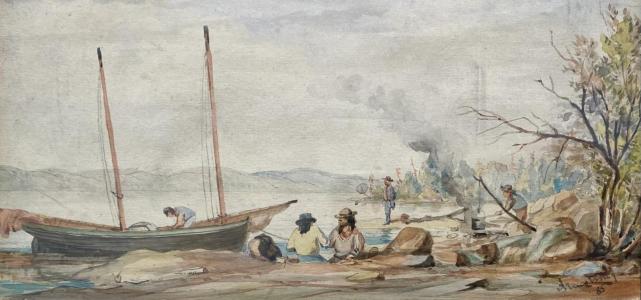William Armstrong - Ojibway crossing the Plains with a Dog Team
- Ojibway crossing the Plains with a Dog Team
- Watercolour on Paper
- 8.5 x 14.5 in
- Sold
- Private Collection
The son of a Royal Irish Artillery officer, William Armstrong studied art in Dublin, and apprenticed as an engineer on the Irish and English railways. In 1851 Armstrong before immigrated to Toronto where he found work with the railway. He co-founded the firm of Armstrong, Beere, & Hime, which specialised as land agents, engineers and photographers.
William Armstrong's skills as a draftsman allowed him to accompany various surveying expeditions into the west. During these expeditions, Armstrong took advantage of the opportunity to travel and sketch extensively in lands then unsettled by Europeans. He took particular interest in the Indigenous peoples of the northern plains, during these years immediately prior to their confinement to reservations.
Amongst Armstrong's most sought after watercolours are those that he completed from sketches completed during his travels in 1859 to Fort William (now the city of Thunder Bay, Ontario). Fort William provided Armstrong with the opportunity to document the evolving commerce of the area. The Indigenous people played an important role in the growing local commerce—particularly the fur trade. By sharing of their knowledge and technology, especially the making and use of birch bark canoes and snowshoes, they enabled the Europeans' success. Many of the watercolours produced during this time were presented to the Prince of Wales on his visit to Toronto in September 1860.
In 1870, William Armstrong accompanied the Wolseley Expedition to the Red River Colony, recording the incredible effort required to move the military force through the Canadian wilderness. Armstrong's painting, Red River Expedition, Purgatory Landing was reproduced as a wood engraving on the cover of the Canadian Illustrated News on July 9, 1870 to accompany their coverage of the expedition's progress.
Armstrong won numerous prizes at provincial exhibitions, and his work was displayed at the 1855 Exposition Universelle in Paris, and at the Dublin International Exhibition in 1865. He exhibited with the Ontario Society of Artists and was a member of the Royal Canadian Academy of Arts until 1887, when he resigned. In 1864 Armstrong began to teach drawing at the Toronto Normal School and then taught at the University of Toronto from 1872 to 1877. Following his retirement, Armstrong continued teaching art from his home until his death in 1914.
More Artwork from this Artist
Hudson Bay Post at Fort William (Caministigoyan)
- Watercolour on Paper
- 7.75 x 11.25 in
- 1910
- Price available on request
Duck Island, Lake Ontario
- Watercolour on Paper
- 4 x 8.25 in
- 1885
- Price available on request
Te.he.do.ne-cha, 1865
- Oil on Board, Photograph on Paper
- 17.5 x 13.5 in
- 1865
- Price available on request



